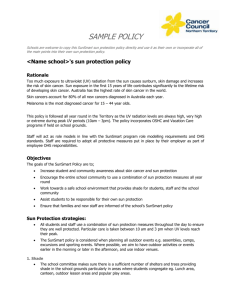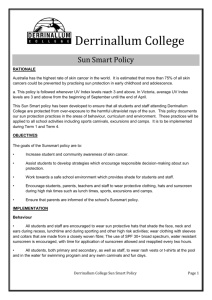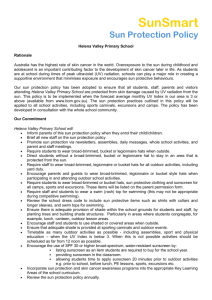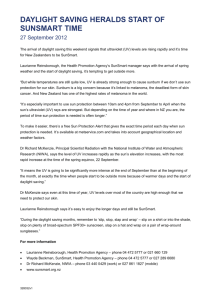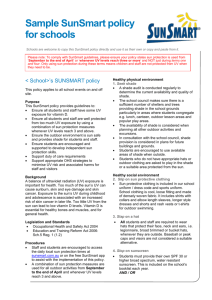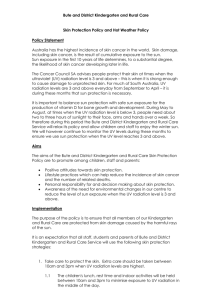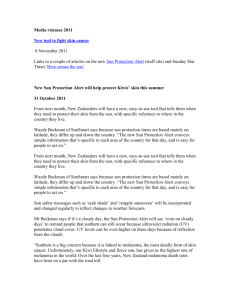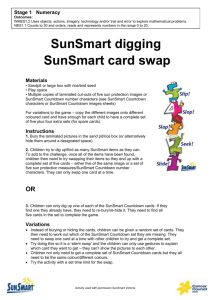Community organisations sample SunSmart policy
advertisement
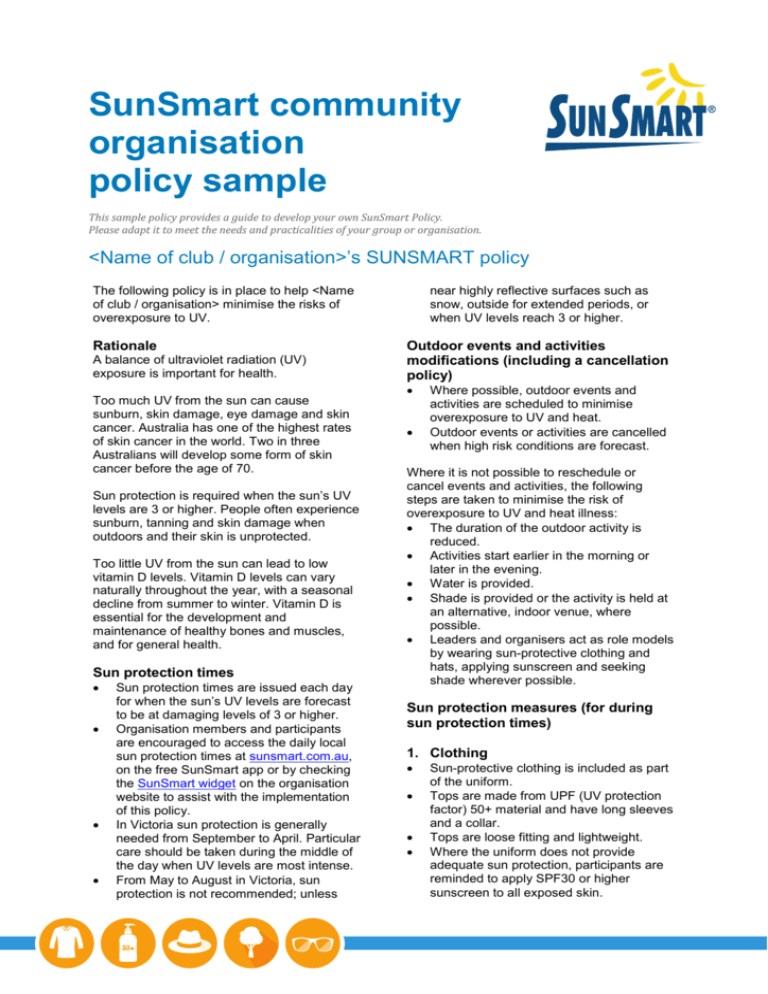
SunSmart community organisation policy sample This sample policy provides a guide to develop your own SunSmart Policy. Please adapt it to meet the needs and practicalities of your group or organisation. <Name of club / organisation>’s SUNSMART policy The following policy is in place to help <Name of club / organisation> minimise the risks of overexposure to UV. Rationale A balance of ultraviolet radiation (UV) exposure is important for health. Too much UV from the sun can cause sunburn, skin damage, eye damage and skin cancer. Australia has one of the highest rates of skin cancer in the world. Two in three Australians will develop some form of skin cancer before the age of 70. Sun protection is required when the sun’s UV levels are 3 or higher. People often experience sunburn, tanning and skin damage when outdoors and their skin is unprotected. Too little UV from the sun can lead to low vitamin D levels. Vitamin D levels can vary naturally throughout the year, with a seasonal decline from summer to winter. Vitamin D is essential for the development and maintenance of healthy bones and muscles, and for general health. Sun protection times Sun protection times are issued each day for when the sun’s UV levels are forecast to be at damaging levels of 3 or higher. Organisation members and participants are encouraged to access the daily local sun protection times at sunsmart.com.au, on the free SunSmart app or by checking the SunSmart widget on the organisation website to assist with the implementation of this policy. In Victoria sun protection is generally needed from September to April. Particular care should be taken during the middle of the day when UV levels are most intense. From May to August in Victoria, sun protection is not recommended; unless near highly reflective surfaces such as snow, outside for extended periods, or when UV levels reach 3 or higher. Outdoor events and activities modifications (including a cancellation policy) Where possible, outdoor events and activities are scheduled to minimise overexposure to UV and heat. Outdoor events or activities are cancelled when high risk conditions are forecast. Where it is not possible to reschedule or cancel events and activities, the following steps are taken to minimise the risk of overexposure to UV and heat illness: The duration of the outdoor activity is reduced. Activities start earlier in the morning or later in the evening. Water is provided. Shade is provided or the activity is held at an alternative, indoor venue, where possible. Leaders and organisers act as role models by wearing sun-protective clothing and hats, applying sunscreen and seeking shade wherever possible. Sun protection measures (for during sun protection times) 1. Clothing Sun-protective clothing is included as part of the uniform. Tops are made from UPF (UV protection factor) 50+ material and have long sleeves and a collar. Tops are loose fitting and lightweight. Where the uniform does not provide adequate sun protection, participants are reminded to apply SPF30 or higher sunscreen to all exposed skin. longer required unless near highly reflective surfaces such as snow, outside for extended periods, or when UV levels reach 3 or higher. 2. Sunscreen SPF30 or higher, broad-spectrum, waterresistant sunscreen is promoted and/or provided to participants. Participants are encouraged to apply sunscreen 20 minutes before going outside and to re-apply every two hours or immediately after swimming or toweling dry. Sunscreen is stored below 30°C and replaced once it has passed the use-bydate. Participants are encouraged to apply a generous amount of sunscreen (the equivalent of one teaspoon per limb). The first-aid kit includes a supply of SPF30 or higher, broad-spectrum, water-resistant sunscreen. Review Relevant documents and links 3. Hats Wide-brimmed or bucket style hats are included as part of the uniform – caps and visors do not provide adequate sun protection to the face, ears and neck and are not recommended. 4. Shade An assessment of existing shade has been conducted at outdoor venues. When not active outside, participants are able to rest in shaded areas. Where there is insufficient natural or built shade, temporary shade structures are provided or participants are notified to bring their own temporary shade (e.g. tents or umbrellas). Shade from buildings, trees and other structures is used where possible Presentation ceremony areas are protected by shade. The schedule allows for participants in outdoor activities to rotate to cooler, shaded areas. 5. Sunglasses Participants are advised to wear sunglasses that meet the Australian standard (ASNZS 1067:2003). Education and information The times when sun protection is required (as determined by daily sun protection times) are communicated to participants and spectators. Participants are notified at the beginning of September that sun protection measures need to be implemented. Participants are notified at the start of May that sun protection measures are no This SunSmart policy will be reviewed biannually to ensure that the document remains current and practical. This policy was last updated on <date>. SunSmart: sunsmart.com.au SunSmart sun protection times widget: http://www.sunsmart.com.au/uv-sunprotection/uv/uv-widget SunSmart app: sunsmart.com.au/app Heat and UV Guide: sunsmart.com.au/downloads/communities/ sports-clubs/uv-exposure-heat-illnessguide.pdf Shade audit: sunsmart.com.au/shadeaudit/ For further information contact SunSmart: P: (03) 9514 6419 E: sunsmart@cancervic.org.au Disclaimer: The information contained in this guide is general in nature and does not constitute medical advice from your doctor or health professional. While all reasonable attempts have been made to ensure the accuracy of the information contained in this guide, SunSmart and associated parties cannot accept responsibility for loss, injury, claim or damage resulting from the use or application of information within this guide. This information is based on current available evidence at the time of writing. It can be photocopied for distribution. Updated: November 2015
